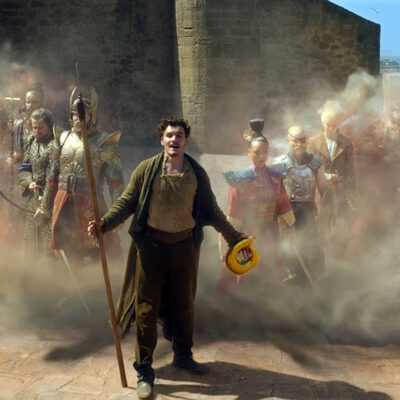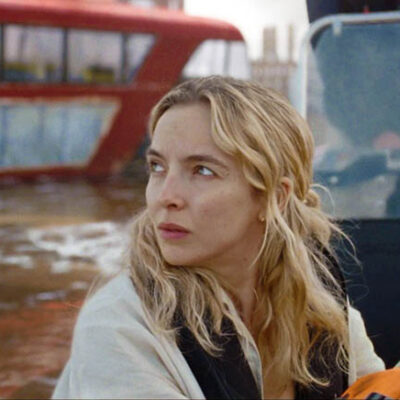By CHRIS McGOWAN
Doctor Who has been a treasured British sci-fi TV mainstay since its debut in 1963 and has also been adapted for movies, plays, books and video games. Now, the “Time Lord” known as “The Doctor” has an increasing presence in virtual reality as well. The BBC has launched two immersive and interactive Doctor Who programs that stretch the space-time-entertainment fabric, each in its own way. Doctor Who: The Runaway (released last May) is a 13-minute animated-short VR experience, while Doctor Who: The Edge of Time (launched in September) is a feature-length VR “narrative video game.” Both The Runaway and The Edge of Time follow on the heels of the franchise’s video game Doctor Who Time Vortex VR, an “endless runner” web/mobile virtual-reality game that launched at the end of 2017.
In The Runaway, actress Jodie Whittaker voices her character, the Thirteenth Doctor in the current BBC series. She recruits the viewer as her assistant in a race against time to return a strange creature called Volta, an unstable ball of living energy, to his home planet. Armed with a sonic screwdriver, the viewer must help the Doctor face down a gang of galactic busybodies who have plans for Volta that are less than benevolent. Along the way, the viewer also gets to pilot the Tardis, a time machine/spacecraft that resembles an old blue English police box on the outside.
“VR enables a childhood dream of stepping inside the screen and taking part in a movie,” says Mathias Chelebourg, the Paris/San Francisco-based director of The Runaway. “I guess any medium has an immersive potential. But VR is creating this unique, perfect conjunction between animation, video gaming and theater. It borrows the strength from the three disciplines and merges them into a unique set of storytelling grammar.”
Chelebourg’s previous VR credits include Alice, the Virtual Reality Play and The Real Thing VR. He also directed the immersive “Alone” episode for the French sci-fi series Missions and has worked as a director for many top advertising clients (including Prada, Dior, Hermes, Chanel, Nike, Microsoft and Renault). BBC VR Hub and Passion Pictures produced The Runaway. Others involved included: MoCap Lab and Atelier Daruma (motion capture), Guillaume Moutardier (sound design), Kombbo (animation), and Innerspace VR (virtual-reality development and real-time VFX).
About the work, Chelebourg comments, “The Runaway is narrative at the core, yet interactivity allows you to build relationships with the characters and makes you [part of it].” In terms of its approach, he adds, “It was clear to me from the start that going for a photorealistic look on a real-time-engine piece was a dead end. So, our first mission was to convince the Doctor Who team and the BBC to let us experiment with a strong art direction implying a certain level of stylization. We knew we were working with preexisting assets that all the fans know by heart and love, but I wanted them to feel unique, original to our immersive take on the show.”
Therefore, Chelebourg hired an artist from illustration and traditional 2D to create a unique illustrative look. “All the textures and fabrics you see in the final environment are hand-painted and beautifully crafted. It’s not trying to mimic reality in any way. If you look closely you can see the strokes of brushes. It has a naive, children’s book feeling that turned out really great and original.”
Chelebourg adds, “Some of our main challenges were related to VR, but most of them were coming from the specific experiential design of The Runaway and Doctor Who generally. One example is that I decided that the entire piece would take place in a single interior environment [The Tardis] over the course of a single long action shot. This is incredibly powerful for the viewer in VR; it uses the strength of continued present time. But it comes with the need of an array of very ambitious animation tricks, insanely complex interactive flow, and different cinematic devices to keep the staging and the performance appealing and surprising until the last minute.
Chelebourg adds, “Some of our main challenges were related to VR, but most of them were coming from the specific experiential design of The Runaway and Doctor Who generally. One example is that I decided that the entire piece would take place in a single interior environment [The Tardis] over the course of a single long action shot. This is incredibly powerful for the viewer in VR; it uses the strength of continued present time. But it comes with the need of an array of very ambitious animation tricks, insanely complex interactive flow, and different cinematic devices to keep the staging and the performance appealing and surprising until the last minute.
“The main decision that I made early in the project was to work with motion capture,” he continues. “Rehearsing and acting this long scene out with actors in the actual space in a very traditional theater way was really key to nailing the performance and being true to the energy of the characters. The result was organic and very believable. Our main animation challenge was then to [add to] this linear performance with a layer of interactivity so that the characters acknowledge your presence [the viewer] in the space, doing so without breaking our material. The result is a very interesting blend of motion capture and traditional and live, reactive animation.”
Explains Chelebourg, “To me, good interactivity in a narrative experience is like good CG on a film – you should not be thinking about it. But if you come out with a sensation of living the adventure and bonding with the characters, it means we have done our job well. So, the piece is highly interactive, yet it’s not filled with gameplays. The characters are reactive; you have an agency over some key moments of the plot, but most of the time you will find yourself screwing up and making things worse. There is no puzzle, no ‘game over.’ All the interactive beats are here to enrich the story.”
The Runaway is available for free download in two versions: an interactive version for Oculus Rift and HTC Vive and a 360 Video version for Oculus Go and Gear VR.
In Doctor Who: The Edge of Time, the very fabric of reality is at stake and the Doctor has been hurled through time to the end of the universe. After escaping an East London laundromat infested with Daleks (merciless and pitiless cyborg aliens), the player must take sonic screwdriver in hand and build a Tardis-summoning device. Once on your way in the Tardis, you must decipher clues, find objects and solve puzzles while journeying to several worlds. The experience is feature-film length, with “stylized photorealistic visuals,” and “pretty much everything in it is interactive,” says Ian Hambleton, CEO of Maze Theory, a London-based VR studio that produced the title with BBC Studios.
“Players will get to experience being inside the show and the Doctor Who franchise,” comments Hambleton. They time travel to Victorian London in a desolate spaceship that needs fixing, and to an alien Dalek-invaded world, and along the way encounter some of the show’s most famous monsters. Indeed, VR’s ability to function like a teleportation device, transporting the viewer/player to – and immersing them in – different places and realities is one of the medium’s main attractions, according to Hambleton. And, “presence,” the feeling that one is inside the virtual reality, can make a VR encounter with a Dalek much more impactful than seeing one on a TV screen.
Maze Theory was founded in September of 2018 and includes former Activision and PlayStation veterans among its executives. Hambleton notes, “We’re a relatively small studio. Creating such a major piece of work [as The Edge of Time] was challenging, but we’re very lucky to have such an incredibly multi-talented team.” Others working on it were Marcus Moresby (Director), Russ Harding (Executive Producer) and Ciaran Devine (Visual Effects Supervisor).
The title, published by PlayStack, can be experienced on the Oculus Rift, PlayStation VR, HTC Vive and Vive Cosmos.
One of the challenges for Maze Theory was guiding the player’s attention. Hambleton explains, “With VR the player is the camera and they can choose what to look at, so we have to try and guide the player in different ways, to focus story and audio around objects and interactions, allowing them to progress at their own pace.”
Regarding his company’s purpose, Hambleton states, “We focus on evolutionary storytelling.” The studio works with “narrative-based, dramatic action where the player actively participates in the story.” About VR, he observes, “While the market’s still in its infancy, we’re seeing a number of new headsets come into the market that are driving the medium forward. As an example, the Oculus Quest, which requires no outside technology, is untethered from any other PC and is fully interactive. Sales of this device and devices like it are positioned to turn VR into more of a mainstream medium.”
Maze Theory is currently working on VR titles Peaky Blinders – The King’s Ransom (based on the BBC gangster series) and The Vanishing Act (which involves an acclaimed inventor, Dr. Pelham, who has perished under mysterious circumstances). The BBC has been experimenting with virtual reality since the 1990s and has produced various titles in recent years, including Congo VR, People Just Do Nothing PR, 1943 Berlin Blitz, Nothing to be Written, Make Noise, Damming the Nile, The Turning Forest, Easter Rising, and Home – a VR Spacewalk.














